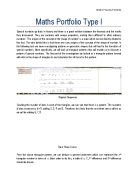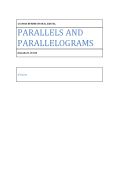Part 2: Sum Pattern
1. The sum of the numbers in each row for the first six rows are as follows:
0th row = 1
1st row 1+1 = 2
2nd row = 1+2+1 = 4
3rd row = 1+3+3+1 = 8
4th row = 1+4+6+4+1 = 16
5th row = 1+5+10+10+5+1= 32
6th row = 1+6+15+20+15+6+1= 64
2. I observed that the sum of every row is the double that of the previous number
3. A general formula is that the Sum of the nth row = 2n
Maths formula per row would therefore be:
Row 0:(x+1)^0 = 1
Row 1:(x+1)^1 = 1 + x
Row 2:(x+1)^2 = 1 + 2x + x^2
Row 3:(x+1)^3 = 1 + 3x + 3x^2 + x^3
Row 4:(x+1)^4 = 1 + 4x + 6x^2 + 4x^3 + x^4
Row 5:(x+1)^5 = 1 + 5x + 10x^2 + 10x^3 + 5x^4 + x^5 ...
Row n: (x+1)^n = 1 + nx + 2nx^2 + 2nx^3 + nx^4 + x^n ...
Part 2a: Alternating Sum Patterns
1.) Below are the alternating sums for each of the first six rows:
0th row 1
1st row 1 1 = 0
2nd row 1 2+1 = 0
3rd row 1 3+3 1 = 0
4th row 1 4+6 4+1 = 0
5th row 1 5+10 10+5 1 = 0
6th row 1 6+15 20+15 6+1 = 0
2.) I notice that they all end in 0.
3.) Alternating sum in row n = 0.
Part 3: Multiple Pattern
1. If you add 2 numbers that are multiples of n, then also the sum will be a multiple, and an interesting pattern appears when certain multiples are highlighted. For example, multiples of 2 and 3 (see diagrams below).
1
1 1
1 2 1
1 3 3 1
1 4 6 4 1
1 5 10 10 5 1
1 6 15 20 15 6 1
1 7 21 35 35 21 7 1
1 8 28 56 70 56 28 8 1
1 9 36 84 126 126 84 36 9 1
The sum of two odd numbers is an even number, i.e. the number occurring below; and the sum of two even numbers is an even number, seen below; but the sum of an odd number and an even number is an odd number which changes the sequence in this case. During my research, I included two patterns for Pascal’s multiples. The red coloration in the first picture shows a symmetrical pattern that is formed when all the even numbers are coloured differently.
The pattern for multiples of 3’s and 5’s were as follows:
1
1 1
1 2 1
1 3 3 1
1 4 6 4 1
1 5 10 10 5 1
1 6 15 20 15 6 1
1 7 21 35 35 21 7 1
1 8 28 56 70 56 28 8 1
1 9 36 84 126 126 84 36 9 1
1 10 45 120 210 252 210 120 45 10 1
1 11 55 165 330 462 462 330 165 55 11 1
1
1 1
1 2 1
1 3 3 1
1 4 6 4 1
1 5 10 10 5 1
1 6 15 20 15 6 1
1 7 21 35 35 21 7 1
1 8 28 56 70 56 28 8 1
1 9 36 84 126 126 84 36 9 1
1 10 45 120 210 252 210 120 45 10 1
On shading multiples of 3 (pink), there were inverted triangles that formed a pattern around the middle of the pyramid. The smaller triangles stood on a base of 2 numbers, and the base of two triangles was separated by one number (20). The height of the triangle is also two rows.
On shading multiples of 5, we have an inverted triangle which again is symmetrical around the middle on a base of four numbers. This pattern is then repeated but this time on two sides of the pyramid, and the base is again separated by one number (252). In this case, the height of the triangle is four rows.
Explanation: Perhaps the triangular patterns are always formed on a base and height of (n-1) in a symmetrical pattern, like two sides of an equilateral triangle.
Part 4: Pascal Petals
1.
1
1 1
1 2 1
1 3 3 1
1 4 6 4 1
1 5 10 10 5 1
1 6 15 20 15 6 1
1 7 21 35 35 21 7 1
1 8 28 56 70 56 28 8 1
1 9 36 84 126 126 84 36 9 1
1 10 45 120 210 252 210 120 45 10 1
Cell 21 (grey petal):
6x28x35 = 5880 = (2x3)x(2x2x7)x(5x7)
15x7x56 = 5880 = (3x5)x(1x7)x(2x2x2x7)
i.e. perhaps there are 21 ways of writing this sets of factors
Cell 6 (turquoise petal):
3x4x10 = 120 = (1x3)x(2x2)x(2x5)
4x10x3 = 120 = (2x2)x(2x5)x(1x3)
i.e. perhaps there are 6 ways of arranging this sets of factors
A B C D
A+B B+C C+D
A+2B+C B+2C+D
Every time you follow the flower-like order, you get the same answers. But I noticed that you have to follow this particular order other wise it you will end up with another (or a wrong) answer.
My explanation: I think the explanation here is that factors when multiplied always result in the same numbers unlike when added or squared up.
Part 5: Sideways Pattern
1st triangular number: The first triangular number will be 1. And if you add 2 you will get the 2nd triangular number.
2nd triangular number: Here as I told you had to add 2 more to one that will bring you to 3. And now you have to add three. You see the pattern every time you have to plus the number with one more.
3rd triangular number: is 6 and then you add 4.
4th triangular number: it will be 10 and you add 5 this time.
5th triangular number: will be 15 and after this you have to add 6.
And so on so on. This pattern will stay for the rest of Pascal’s triangle.
Extra:
-
(a+b)6
Since (a+b)3 = a3+3a2b+3ab2+b3 i.e. row 3 pattern of …… 1 3 3 1
And row 6 pattern is….1 6 15 20 15 6 1
Therefore, (a+b)6 = a6+6a5b+15a4b2+20a3b3+15a2b4+6ab5+b6
-
(a-b)7
Since row 7 pattern is….1 7 21 35 35 21 7 1
Therefore, (a-b)7 = a7-7a6b+21a5b2-35a4b3+35a3b4-21a2b5+7ab6-b7
-
(2x-1)3
And (a+b)3 = a3+3a2b+3ab2+b3; where a=2x and b=-1
Answer: (2x)3 + 3.4x2.-1 + 3.2x.1 + (-1)3 = 8x3- 12 x2+ 6x.1 -1.
-
(x+1/x)4
Since row 7 pattern is….1 7 21 35 35 21 7 1
And (a+b)4 = a4+4a3b+6a2b2+4ab3+b4; where a=x and b=1/x
Answer: x4+ 4x3/x + 6x2/x2+ 4x/x3+1/x4 = x4+ 4x2 + 6 + 4/x2+1/x4
= x4+ 4x2 + 6 + 4/x2+1/x4
Bibliography
- http://mathforum.org/workshops/usi/pascal/elem.color_pascal.html







